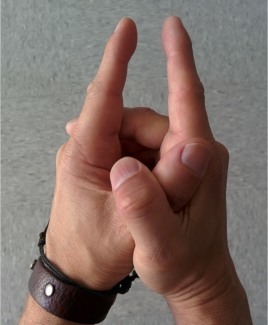Never panic at the thought of performing suggestibility tests again!
Discover how suggestibility tests induce and deepen hypnotic trance, and how to use them without fear.
You may have some questions about suggestibility tests - we get a lot of them. For instance:
In this Comprehensive Guide to Suggestibility Tests, not only do we look at the various ways to test for suggestibility, but also how suggestibility tests can be used as convincers when first introducing hypnosis to your subjects, and to test for depth of trance during a hypnotic session.
We will answer these questions AND give you examples that you can add to your hypnosis "suggestibility test" repertoire if you don't already know them.
So, what IF your hypnosis subject doesn't take your suggestion on the first go round?
Or what if they aren't convinced by the convincers? Or maybe they just aren't that deep in trance when you test for depth of trance.
What then?!?
Should you just keep trying?
Well, yes, but doing the same thing over and over again may not get you the outcome you want. Flexibility and confidence are key, in all of these scenarios. You get that flexibility and confidence with knowledge and practice. This guide will provide you with the knowledge - the practice is up to you!
Section 1: Suggestibility Tests Explained
Should you, or shouldn't you?
Whether you are new to the practice of hypnotherapy, a brand new stage hypnotist, or a seasoned professional in either arena, fear of the dreaded suggestibility test can sneak up and attack from behind. After all, what if you have a subject standing in front of you and they don't take your suggestion?
Doesn't that mean failure???
When you give a suggestibility test, is failure an option?
The only way a suggestibility test can fail is if you do it wrong. And even then, you can just do it again.
Now, please understand that the success of a suggestibility test does not only occur when the subject follows your suggestion. A suggestibility test, just like when testing for depth of trance or any other test, for that matter, is an information gathering device. That's all.
When using suggestibility tests, you are looking to learn how easily your subject responds to suggestions. That's it. There is no fail, as long as you form the suggestions in a way that gives them the best chance to do what you ask.
If they follow your suggestions easily, yay! If they don't, well then you have some work to do to help them learn how to follow your suggestions for their own benefit.
How to perform effective suggestibility tests
So have a couple of suggestibility tests handy (there are some examples further along in this guide). Do these tests with confidence, and they will not only inform you so that you can help your subject go into hypnosis easily, but they can work as convincers for your client (subject, friend, audience).
One of the classic suggestibility tests is the finger vice.
The finger vice is where you interlace your fingers and pull your index fingers apart (see image). You then suggest that there are magnets attached to the index fingers — pulling those fingers together. Use your language to emphasize the magnetic force, have them concentrate on feeling that pull and positively reinforce the suggestions as their fingers move together.
When their fingers touch, you can suggest that they press tightly together and that the more they try to pull them apart, the tighter they will squeeze together.
After a few seconds, suggest the finger release.
Suggestibility tests can be used in therapeutic hypnosis and are often used by stage hypnotists to pick out the best responding subjects from an audience.
Section 2: Hypnotic Convincers
Are Suggestibility Tests Hypnotic Convincers?
When you’re hypnotizing someone (or about to), a convincer’s job is to get the subject to think a certain way. In other words, you want your subject to respond to your suggestions...rather than suggestions that the person is giving themselves. So although they are related, suggestibility testing is not the same thing as a utilizing convincers.
You see, a person’s thoughts can be thought of as internal suggestions. Often these internal suggestions are counter productive, and don't help the subject at all. Not to mention getting in the way of you being able to do your best work.
For instance, if you’re saying, “Your eyes are getting very heavy,”
...
and the person you’re talking to is thinking, “This hypnosis stuff is crap. It’s never going to work,”
then you may have a problem.
Resolving Inner Conflict Using Convincers
In the situation mentioned above, you have two, conflicting suggestions going on. And oftentimes, a person will take their own suggestions over yours - so you need to get them working WITH you, rather than against you.
A convincer helps the hypnotic subject think a different thought, such as, “Wow, something is going on here. This stuff works.” It is also a good time to help the subject know that they are an active participant in the process.
Common convincers include the eye closure portion of many inductions, as well as the Book and Balloon, and the Lemon Slice. You can also do “waking hypnosis” as a convincer.
You can suggest that a person lay their hand flat on a table and concentrate on imagining their hand being part of the table. It’s as if they’re carved out of one, solid block of wood. You can use language such as, “Concentrate on the idea that your hand and the table are one and find that, the harder you try to move your hand, the more it stays there, as long as you hold that thought.”
In this format, the language in the paragraph above serves to perform the function of both suggestibility test AND hypnotic convincer.
Note: Make sure you eventually suggest that their hand return to normal.
Disguised Suggestibility Tests
Some inductions include what’s called “disguised testing.” With a disguised test, you don’t tell the subject that it’s a test.
Watch the video, and then read more below.
It might help your subject to think of these suggestions (disguised suggestibility tests) as using their imagination. How well do they use their imagination to a useful purpose?
Think of it (and frame it) as an “imagination exercise,” or “responsiveness skill-building.”
That way, if a person doesn’t respond well at first, you can help them re-shape their thinking and learn how to help you help them.
For instance, what do you do if you suggest a subject’s eyes relax to the point where they stay closed, even when they try to open them, and the subject opens their eyes?
You can say, “Not bad for the first time", or "Good, you've proven to yourself that you are in control. Now, each time you concentrate on this idea, you get better at allowing your eyes to stay closed. Now, concentrate on the idea that they’re so relaxed, they refuse to open, they just stay closed.”
Frame it as skill-building, rather than a failure. Use this to help them learn how to work with you to go into hypnosis, so they can get what they want.
Then, once they’re successful, these tests function as hypnotic convincers. They show themselves the power of the suggestion, and of hypnosis and their own minds.
You can also help foster the “this is working” attitude by explaining to a client or subject, what their role is. “When I give you a suggestion, your job is to automatically think, ‘Yes!’ We’ll take some time before you experience hypnosis to make sure I’ll only give you suggestions you approve. Once we work out the suggestions together, your job is to have an accepting mind.”
When a hypnotic subject understands their role this way, and already has some taste of success to help convince them it’s going to work, your job is much easier!
Section 3: Testing For Depth Of Trance
How do you know when you've got a good level of trance to work with? You can use the same things you used as a suggestibility test or convincer.
One way to check for depth of trance can be checking for the elements we look for as signs of hypnosis... just by asking. For instance, a hypnotist might ask a subject to concentrate on their arm being so heavy that they couldn't move it. If the subject couldn't move the arm then they would have "passed" the test.
So, should you test your subject to find out how deep they are? The answer depends on what school of thought you follow with regards to hypnosis. Most hypnotherapists hold one of three opinions on the subject of testing.
- Test your client to find out how deep they are.
- Do not test your clients - If they fail a test for depth, they may believe they're not a good subject and/or they'll think you're a bad hypnotherapist.
- Level of trance is not important. A client can create change at any level of trance.
The Role Belief Plays In Suggestibility Tests, Convincers, and Depth Of Trance Testing
If your subject believes that they are experiencing hypnosis, it can help. The reason has to do with the internal suggestions your subject gives themselves. If, while you are giving suggestions, your subject is thinking "Wow, I'm really experiencing trance here - these suggestions are going to work great," then they're giving themselves suggestions that increase the power of what you are saying. If your subject is thinking "I'm not in trance, this isn't working for me," then the suggestions they are giving themselves run counter to what you are trying to do.
It's for this reason that I find testing extremely useful. Not only does it give me an idea of how the client is progressing, but it is a "convincer" for the client. The Modified Elman Induction contains tests along the way for catalepsy of the eyelids, catalepsy of an arm, and amnesia.
When people experience these things they usually have the feeling that something is happening that is different than their normal experience. That, coupled with a good pre-induction talk helps the majority of people you'll work with to understand when they're experiencing trance, and accept it.
I like disguised testing such as in Elman Induction. If we give a test without saying we're giving a test, we overcome the objections of people who are afraid to test (it's kind of a wimpy objection anyway - mostly put forward by hypnotherapists who are not confident).
The testing is also used as a deepening procedure.
Suggestibility Testing As A Convincer
Testing for depth of trance during an induction can act as both suggestibility test, and convincer. You are, of course, looking for feedback and information so you can do your job. AND, as the subject successfully produces hypnotic phenomena, you have to opportunity to congratulate them on doing such a fine job of going into hypnosis.
I've included some language for some of these convincers here. It is presented as if you are working with a group, but it can work just as well for an individual, of course.
Section 4: Suggestibility test examples

The Lemon Slice Test
Here is an example of a script for the lemon slice suggestibility test:
"You see, when the mind concentrates fully enough on a thought, the body automatically acts as if that idea is true. Let's find out just how well you can concentrate and imagine.
Everyone, close your eyes if you want to participate, and imagine there is a lemon slice in your hand.
Notice the way the light glints off the lemon slice and notice the color. Pretend you can feel the weight of it in your hand - and feel the texture.
As you squeeze the lemon slice, listen to the sound and feel the juice on your fingers. (Continue on for a moment or two asking them to see, hear and feel the lemon. Don't get too specific - their lemon might not look like the one in your imagination)
Notice the details as you bring the lemon up closer to your mouth and take a big, juicy bite out of it...taste it...feel it on your lips"
(Notice those who are puckering up and look like they're biting into something sour. Keep track of those folks; they may be your best hypnotic subjects).
Ask them to try and whistle. Ask how many people salivated at the thought of the lemon or puckered up at the thought of a sour taste. Congratulate those who did. Comment that those who were able to concentrate sufficiently found out how the mind and the imagination, when properly focused, can cause the body to react automatically.
Book And Balloon
Next comes an oldie but goodie - the 'book and balloon.'
Are you ready? Here's an example script - remember, involve all of the senses if you can!
"OK, everyone please hold out both of your arms straight in front of you, parallel to the floor. Now, make sure one of your palms is facing the floor and the other toward the ceiling. Close your eyes and begin to imagine that the palm up hand has a heavy book in it. Imagine that you can feel the texture of the cover as the weight presses down on your hand. As heavy things do, the book seems to grow heavier with each passing moment. In your mind's eye you can see the color of the book and almost smell it as it grows heavier. Now for the palm down hand, imagine there is a bunch of various colored helium filled balloons tied to your wrist. They want to lift that arm upward pulling it higher as the other arm grows heavier. The balloon arm gets lighter and lighter as the book arm gets heavier and heavier."
(By this time you'll probably already see people with the book arm moving toward the floor and the other arm moving upward. Keep going, alternately suggesting that the palm up hand with the book in it is growing heavier and heavier and that the balloons are lifting up the light hand. When you talk about the heavy hand speak in a deeper heavier voice. When you talk about the light hand speak in a higher, lifting voice. At a point where you feel you've gotten a good result, notice who is responding the best and say...)
"Keep your arms where they are and open your eyes." Many people will be surprised that their arms have moved. "You see, that's how powerful the mind is when you can concentrate strongly enough on an idea."
Hand Clasp
Pick out a subject who has been performing well and ask them to help you find out how strong their powers of imagination and concentration are. Stand, facing your subject and ask them to look you directly in the eyes and concentrate completely on the ideas behind your words. If at any time they begin to look away, command them to look directly into your eyes (point to your eyes) and concentrate completely and fully on your words.
"Put your arms straight out in front of you, parallel to the floor, put your palms together and interlock your fingers. Push your hands together as tightly as you can and concentrate on the idea 'My hands are stuck together, my hands are stuck together.' As you push your hands together, sticking them together, your arms grow stiff and rigid, stiff and rigid as your hands lock more tightly together as if they're made of one solid piece of granite. (Continue to look them straight in the eye). Now, as you fully and completely concentrate on the idea that your hands are one solid piece of granite try in vain to pull them apart and find that they are stuck together, stiff and rigid, stuck together." (Let them try for two or three seconds - no more). Good. Stop trying and now allow those hands to become loose and limp and release easily. (Occasionally people still have a problem getting their hands apart. Just grab them and gently shake them loose saying "They can relax now and let go.")
Steel Arm
Explain to your subject that you are going to "borrow their arm" for a moment. Take your subject's arm and hold it out at right angles to their body. Suggest that their arm is growing stiff and rigid like a steel bar and no matter how hard they try to bend it will remain straight like a steel bar. Tell them to try and bend it and find that it remains stiff and rigid like a steel bar. After a few seconds of trying, remove the suggestion. "In a moment I will count to three and snap my fingers. Your muscles will relax and you will easily be able to bend your arm. On the number three your arm will drop down to your side and you will go deeper. One, more relaxed, two, nice and easy, three (snap fingers). Drop your arm and go deeper."
Unable To Stand/Sit
Tell your subject that his/her muscles are becoming so stiff and rigid that soon he/she will be unable to get out of the chair. "Your legs are growing stiff and rigid, stiff and rigid. Your legs are locked into position and growing more stiff and rigid with each passing moment. Soon it will be as if you are unable to stand up. Stiff and rigid, stiff and rigid. Try to stand and find that it is as if you are stuck to the chair, stuck to the chair, stiff and rigid." After a moment remove the suggestion in this way; "In a moment I will count to three and snap my fingers. Your muscles will relax and you will easily be able to stand up. One, more relaxed, two, nice and easy, three (snap fingers). Stand up (help them stand up)."
(For this next portion, make sure that you are in a position to keep your subject safe. Don't do this with anyone who you are not strong enough to help hold up.)
"Your legs are straight and strong beneath you; in fact your legs are becoming stiff and rigid again. Stiff and rigid, stiff and rigid. Your legs and hips are so stiff and rigid that it is as if you cannot sit down. Try to, and find that you are unable because you are so stiff and rigid. In a moment I will count to three and snap my fingers. Your muscles will relax and you will easily be able to sit down. One, more relaxed, two, nice and easy, three (snap fingers). Sit down and go deeper." Help them sit down safely.








What is the purpose of the Red script in hynosis?
I don’t know what you mean by the red script.
Keith